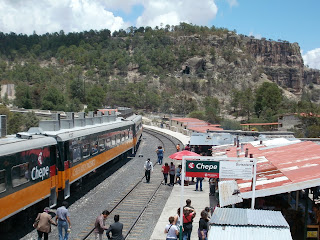Creel
I took the bus from Chihuahua, Mexico, to Creel, 280 pesos (less than $28). The six and a half hour ride was 185 miles on mostly flat highways, with little rolling hills, and narrow, curved mountain roadways the last 60 miles. Again, I was the only non-Mexican on the bus. I’m getting use to it, but I wouldn’t complain if I ran into another Norte Americano. The bus driver reminded me of “The good, the bad, & the ugly” actor Lee Van Cliff (“the bad”). He certainly handled the large bus through the curves with wreak-less abandon. The bus drivers in Mexico earn their reputation of being muy macho.
Big modern bus station in Chihuahua
Muy macho bus driver
I’m perched on top of the Sierra Madres at 8,000 feet, light headed, a little cold, excited, and fully alive. The thin air challenges my lungs to breath. Nothing like having to take deep breaths of fresh air to know you’re still living. I felt tingling as my body adjusted to the new environment. It let me know I can adapt and thrive high up in the clouds, close to the heavens. I didn’t bring any foul weather gear, thinking I wouldn’t need any until I reached the Andes in South America. I’m staying in a little pueblo named Creel, awaiting the “El Chepe” train through Los Barrancas del Cobre, the Copper Canyon, on to the Pacific coast city of Los Mochis.
Creel is wonderful. I highly recommend a visit. Surrounded by rugged, forested mountains, it is a very romantic little town. There are lot’s of Mexican couples promenading through the small plaza holding hands, hugging, and enjoying each other’s company. Tarahumara (indigenous mountain people) women and children are selling their wares. Smells of roasting corn, sweet pine tree, and refreshing rain assault the senses. The intriguing clicks and high pitches of the Tarahumara language mix with the more familiar Spanish. Beautiful, passionate live Latin music (“besame, besame mucho . . . kiss me, kiss me as if tonight is the last time together”) escapes from a second story cocktail lounge and reminds me of deep friendship and missing familiar faces.
I stayed at the Posada de Creel, and at 250 pesos (less than $25), it met my budget requirements. The room was small, clean and safe, with a steady stream of hot water, a towel, toilet paper (don’t laugh, when traveling this small item becomes a luxury), but no soap. I have my own. I’m also traveling with an adequate supply of toilet paper, which I know I’ll need.
Colorful Creel
Mexico loves it's churches
Tarahumara people making a living at the Plaza
Some of what they sell
Preparing for another day of selling
I purchased a hand woven bracelet from this young vendor
Riding the Train through Copper Canyon
It’s difficult to put into words the splendor and magnificence of Barrancas del Cobre (Copper Canyon). It is the most wondrous natural site I’ve ever experienced. It’s a series of canyons. When one travels through the area, you know there must be a superior being who created the world. This just didn’t happen on its own. Thank You God, Goddess, Spiritual Being, Allah (you fill in the name) for allowing me to experience this natural phenomena. I recommend to everyone to visit on the train -- El Chepe. From Creel to El Fuerte, it’s $90 dollars. Riding the full length is around $180 dollars. I initially planned to disembark from the train at El Fuerte, two hours before Los Mochis. There was a change of plans.
El Chepe train had clean, bigger bathrooms than Amtrak -- with toilet paper. The train seats were spacious and comfortable, with a dining car that served not to expensive tasty meals (again, better than Amtrak). The conductors explained the flora and fauna, for example after we passed the actual Copper Canyon, the trees changed from thick, tall, sugar pines, to wild apple, mango, and avocado trees. This was my favorite part of the ride. I was left awed and humbled in the shadow of these oversized rugged, deep canyons. Some of the rock formations looked like they were carved by artists to depict abstract figures. It reminded me of Michelangelo’s later unfinished sculptors. The area is “owned” by the Tarahumara people. Even though they are poor, they do not allow cutting of the forest. They set the example for being honorable caretakers of nature.
El Chepe stopping at Copper Canyon
Barrancas del Cobre
Another view
Unpolluted streams
Magnifient waterfalls
Rugged, forested mountains
Clear lakes
Copper Canyon is one of the world’s treasures, and fairly easy to visit. If you don’t want to go alone, you will need to speak Spanish, I recommend a tour. It’s pure wild, wilderness, unpolluted nature, with clean waterfalls, rivers flowing with rapids, tall trees, and rugged, high canyons. Please, don’t forget to invite me when you go.
Manny de riding the rails with new friend Martin
If I have the opportunity, on my next posting, I’ll relate a twenty-nine hour, 1,460 mile, nonstop travel odyssey that I do not recommend for the weak of heart, but yes, for the weak of mind -- that’s probably why I did it.


















































